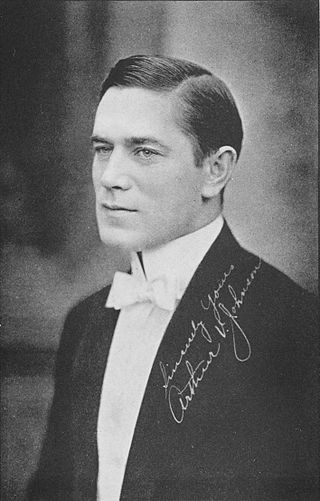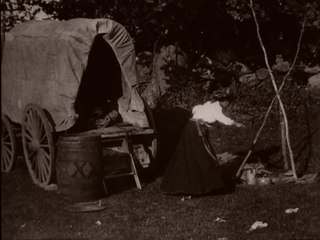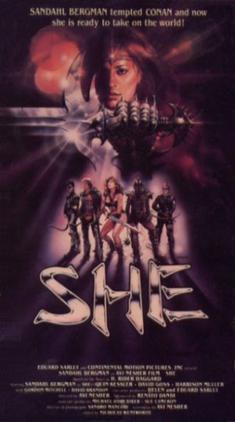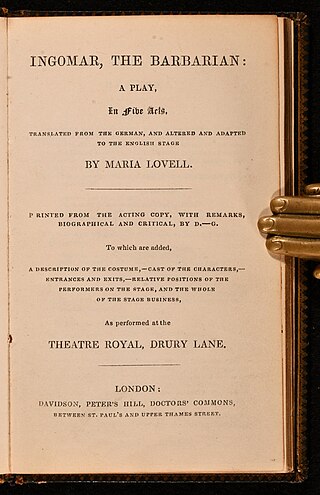
Arthur Vaughan Johnson was a pioneer actor and director of the early American silent film era, and uncle of Olympic wrestler and film actor Nat Pendleton.

The Golden Louis is a 1909 American drama film written by Edward Acker, directed by D. W. Griffith, and produced by the Biograph Company in New York City. Originally, this short was distributed to theaters on a "split reel", accompanying another Griffith-directed film, the comedy The Politician's Love Story.

Linda Arvidson was an American stage and film actress. She became one of America's early motion picture stars while working at Biograph Studios in New York, where none of the company's actors, until 1913, were credited on screen. Along with Florence Lawrence, Marion Leonard, and other female performers there, she was often referred to by theatergoers and in trade publications as simply one of the "Biograph girls". Arvidson began working in the new, rapidly expanding film industry after meeting her future husband D. W. Griffith, who impressed her as an innovative screen director. Their marriage was kept secret for reasons of professional discretion.
George Gebhardt was an American silent film actor. He appeared in more than 120 films between 1908 and 1922. He was born in Basel, Switzerland and died in Edendale, Los Angeles from tuberculosis.

The Adventures of Dollie is a 1908 American silent drama film directed by D. W. Griffith. It was Griffith's debut film as a director. A print of the film survives in the Library of Congress film archive. The film tells the story of a young girl who, after being kidnapped by a peddler, ends up trapped in a barrel as it floats downriver toward a waterfall.
After Many Years is a 1908 American silent drama film directed by D. W. Griffith. Prints of the film exist in the Library of Congress film archive. The film is an adaptation of Enoch Arden.

Ramona is a 1910 American short drama film directed by D. W. Griffith, based on Helen Hunt Jackson's 1884 novel Ramona. Through a love story, the early silent short explores racial injustice to Native Americans and stars Mary Pickford and Henry B. Walthall. A copy of the print survives in the Library of Congress film archive. The film was remade in 1928 with Dolores del Río and 1936 with Loretta Young.

The House of Darkness is a 1913 American short drama film directed by D. W. Griffith.

The Greatest Thing in Life is a 1918 American silent drama film about World War I, directed by D. W. Griffith and starring Lillian Gish, Robert Harron, and David Butler. The film is now considered lost as no prints are known to exist.

Gladys Egan was an early 20th-century American child actress, who between 1907 and 1914 performed professionally in theatre productions as well as in scores of silent films. She began her brief entertainment career appearing on the New York stage as well as in plays presented across the country by traveling companies. By 1908 she also started working in the film industry, where for six years she acted almost exclusively in motion pictures for the Biograph Company of New York. The vast majority of her screen roles during that period were in shorts directed by D. W. Griffith, who cast her in over 90 of his releases. While most of Egan's films were produced by Biograph, she did work for other motion-picture companies between 1911 and 1914, such as the Reliance Film Company and Independent Moving Pictures. By 1916, Egan's acting career appears to have ended, and she no longer was being mentioned in major trade journals or included in published studio personnel directories as a regularly employed actor. Although she may have performed as an extra or in some bit parts after 1914, no available filmographies or entertainment publications from the period cite Egan in any screen or stage role after that year.

The Call of the Wild is a 1908 American short silent Western film directed by D. W. Griffith and produced by the American Mutoscope and Biograph Company. The short, a "one-reeler", stars Charles Inslee, Harry Solter and Florence Lawrence. Its interior scenes were shot at Biograph's studio facilities in New York City, and its exteriors were filmed on location in Coytesville, today one of the oldest communities in Fort Lee, New Jersey.

She is a post apocalyptic film directed by Avi Nesher and starring Sandahl Bergman. She was based on H. Rider Haggard's 1887 novel She: A History of Adventure.

America, also called Love and Sacrifice, is a 1924 American silent historical war romance film. It describes the heroic story of the events during the American Revolutionary War, in which filmmaker D. W. Griffith created a film adaptation of Robert W. Chambers' 1905 novel The Reckoning. The plot mainly centers itself on the Northern theatre of the war in New York, with romance spliced into the individual movie scenes.

An Arcadian Maid is a 1910 American silent drama film directed by D. W. Griffith and starring Mary Pickford. It was produced and distributed by the Biograph Company.
The Greaser's Gauntlet is a 1908 American silent short adventure film directed by D. W. Griffith. It was released by the Biograph Company and copyrighted on August 6, 1908. The film introduced the first extended use of parallel editing in Griffith's work.

Alberta Gallatin was an American stage and film actress active in the late 19th and early 20th centuries. During her near forty-year career she acted in support of the likes of Elizabeth Crocker Bowers, James O’Neil, Edwin Booth, Joseph Jefferson, Thomas W. Keene, Richard Mansfield, Sir Johnston Forbes-Robertson, Minnie Maddern Fiske, Otis Skinner, Maurice Barrymore, Joseph Adler, E. H. Sothern and James K. Hackett. Gallatin was perhaps best remembered by theatergoers for her varied classical roles, as Mrs. Alving in Henrik Ibsen's domestic tragedy Ghosts and the central character in the Franz Grillparzer tragedy Sappho. Counted among her few film roles was the part of Mrs. MacCrea in the 1914 silent film The Christian, an early 8-reel production based on the novel by Hall Caine.

As It Is In Life is a 1910 silent short film directed by D. W. Griffith and produced and distributed by the Biograph Company. Mary Pickford appears in the film.

Maria Ann Lovell or Maria Lovell; Maria Lacy; Maria Ann Lacy (1803–1877) was an English actress and playwright, often referred to as Mrs G. W. Lovell. She acted under the name Miss Lacy.

The toga play was a theatrical genre popular at the end of the nineteenth century and the start of the twentieth century. It combined plots from popular novels with inspiration from Victorian painters and composers, all set against a classically themed background.

Ingomar the Barbarian is an 1851 historical play by the British writer and former actress Maria Ann Lovell. It was based on the German play Der Sohn der Wildnis by Friedrich Halm. It premiered at the Theatre Royal, Drury Lane on 9 June 1851. The original cast included John Garside Neville as the Timarch of Masillia, James Robertson Anderson as Ingomar and Charlotte Vandenhoff as Parthenia. It appeared frequently on the American stage for the remainder of the nineteenth century.

















